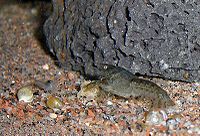Mexican Dwarf Crayfish (Cambarellus patzcuarensis)
Mexican Dwarf Crayfish
Cambarellus patzcuarensis
38 Litres (10 US G.)
3.8-5.1cm (1.5-2 ")
Freshwater
7.5 - 8.0
22 -24 °C (71.6-75.2°F)
12-14 °d
1:1 M:F
2-5 years
Contents
Alternative names[edit]
- Mexican Dwarf Crayfish, CPO
Origin[edit]
- They inhabit Lake Patzcuaro in Central Mexico as well as the southern parts of the U.S. Their preferred habitats consist of lakes, small streams and slow-flowing rivers
Sexing[edit]
Adult males are distinguished by the first pair of pleopods, which are rigid with terminal hooks at the forward end (between the last pair of walking legs). In females the first pleopods are flexible and similar to the other four pairs of pleopods.
Tank compatibility[edit]
They generally coexist harmoniously with small fish and typically refrain from attacking even newborn guppies. However, they may prey on fish eggs or non-swimming larvae, and will scavenge on dead fish. Additionally, some aquarium hobbyists have experienced that these crayfish will also attempt to devour dwarf shrimp such as cherries. It is absolutely essential to provide them with hiding places when they commence molting, as the new shell is soft, allowing even small fish (or other crayfish) to kill them during this period. Volcanic rock riddled with numerous small holes, or short segments of waterlogged bamboo furnish useful molting refuges. Never keep them with loaches or similar fish that explore nooks and crannies since such fish will devour the crayfish during their molt.
Diet[edit]
They tend to thrive on a varied diet that contains both meaty (live or frozen worms and pellets formulated for scavenging crustaceans) and herbivorous foods (vegetables or algae-based foods). They also appreciate leaf litter that they can graze on. To ensure that their colors remain bright, incorporate occasional meals of color-enhancing foods rich in natural carotenoid pigments such as the astaxanthene found in Cyclop-Eeze.
Feeding regime[edit]
Feed them small servings of crustacean pellets and vegetable matter on a daily basis.
Environment Specifics[edit]
Although harmless to most tank inhabitants, these crayfish can nevertheless pose a danger to each other, especially after molting. This makes it imperative to provide ample hiding places or cover in the form of plants, small stacked driftwood, or caves of clay or PVC. A pair will flourish in a five gallon (20-L) tank, or can be part of a larger, peaceful community of small fish and invertebrates.
Behaviour[edit]
- Largely peaceful to other species sharing their tank but some aquarium hobbyists have experiences that they devour dwarf shrimp if provided with the opportunity to do so.
Identification[edit]
- Most specimens found in the wild are brown, sometimes with a grey or blue tint. Cambarellus patzcuarensis var. "Orange" is an orange-coloured mutation often held in aquariums, but this form is rarely found in the wild.

